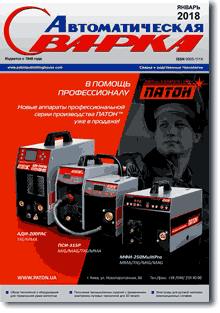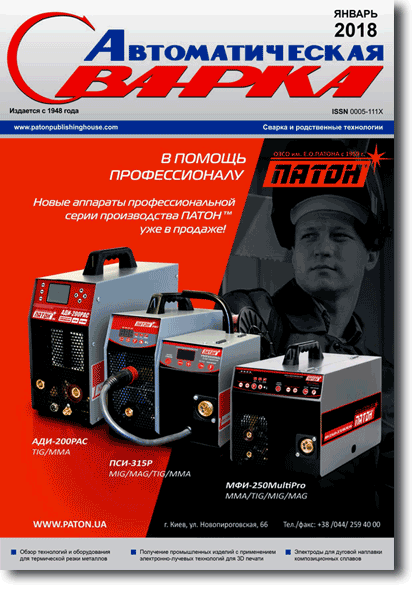| 2018 №01 (06) |
DOI of Article 10.15407/as2018.01.07 |
2018 №01 (08) |

Avtomaticheskaya Svarka (Automatic Welding), #1, 2018, pp. 44-49
Influence of flux composition on the process of electroslag surfacing of end faces with discrete feeding of filler material
Yu.M. Kuskov
E.O. Paton Electric Welding Institute of the NAS of Ukraine 11 Kazimir Malevich Str., 03150, Kyiv, Ukraine. E-mail: office@paton.kiev.ua
Abstract
Applicability of fluxes of different grades at electroslag surfacing of end faces by discrete filler material in a current-supplying mould was studied. It is found that selection of fluxes proceeding just from their physical properties (viscosity and electrical conductivity) does not guarantee the conditions required for conducting the electroslag process. Optimum position of the billet end face to be surfaced in the mould working cavity is very important for normal operation of the mould and performance of sound surfacing with good formation of the deposited metal. In view of the above-said, ANF-29, ANF-32, ANF-26 fluxes can be used for electroslag surfacing with discrete material. 20 Ref., 2 Tables, 4 Figures.
Keywords: electroslag surfacing of end faces, flux, discrete filler, current-supplying mould, current, voltage, process stability
Received: 12.09.17
Published: 15.02.18
References
- Ksyondzyk, G.V. (1975) Current-supplying mold providing rotation of slag pool. Elektrometallurgiya, 27, 32–40 [in Russian].
- Medovar, L.B., Chernets, A.V., Grabovsky, Ts.F. et al. (2000) Experience of manufacture and application of high-speed rolls of ESS LM. Problemy Spets. Elektrometallurgii, 3, 3–9 [in Russian].
- Medovar, B.I., Tsykulenko, A.K., Medovar, L.B. et al. (1997) Electroslag processes without consumable electrodes. Ibid., 2, 12–16 [in Russian].
- Medovar, B.I., Saenko, V.Ya., A.K., Medovar, L.B. (2000) Manufacture of billets of corrosion-resistant bimetal by electroslag surfacing method. Ibid., 2, 3–11 [in Russian].
- Medovar, L.B., Bents, M.J. (1998) Current-supplying mold for electroslag refining of titanium alloys with independent control of slag temperature, speed of slag rotation and speed of electrode melting. Ibid., 4, 13–15 [in Russian].
- Zajtsev, V.A., Medovar, L.B., Tishchenko, P.I. et al. (2011) Application of ESR by a two-circuit scheme for obtaining steel-copper billets of anodes of DC arc furnaces. Elektrometall., 2, 3–7 [in Russian].
- Medovar, L.B., Tsykulenko, A.K., Chernets, A.V. et al. (2000) Examination of influence of two-circuit scheme parameters of ESR on dimensions and shape of metal pool. Problemy Spets. Elektrometallurgii, 4, 3–7 [in Russian].
- Kuskov, Yu.M. (2003) A new approach to electroslag welding. Welding J., 4, 42–45.
- Kuskov, Yu.M., Beskorovajny, V.I., Us, V.I., Medovar, L.B. (1992) Electrodeless electroslag technology of copper wastes remelting. Problemy Spets. Elektrometallurgii, 3, 29–32 [in Russian].
- Kuskov, Yu.M., Gordan, G.N., Bogajchuk, I.L. et al. (2015) Electroslag surfacing using discrete materials of different methods of manufacture. The Paton Welding J., 5–6, 30–33. https://doi.org/10.15407/tpwj2015.06.06
- Latash, Yu.V., Medovar, B.I. (1970) Electroslag remelting. Moscow, Metallurgiya [in Russian].
- Medovar, B.I, Tsykulenko, A.K., Shevtsov, V.L. et al. (1968) Metallurgy of electroslag process. Kiev, Naukova Dumka [in Russian].
- Podgaetsky, V.V., Kuzmenko, V.G. (1988) Welding slags: Welding manual. Kiev, Naukova Dumka [in Russian].
The cost of subscription/purchase order journals or individual articles
| Journal/Currency | Annual Set | 1 issue printed |
1 issue |
one article |
| TPWJ/USD | 384 $ | 32 $ | 26 $ | 13 $ |
| TPWJ/EUR | 348 € | 29 € | 24 € | 12 € |
| TPWJ/UAH | 7200 UAH | 600 UAH | 600 UAH | 280 UAH |
| AS/UAH | 1800 UAH | 300 UAH | 300 UAH | 150 UAH |
| AS/USD | 192 $ | 32 $ | 26 $ | 13 $ |
| AS/EUR | 180 € | 30 € | 25 € | 12 € |
| SEM/UAH | 1200 UAH | 300 UAH | 300 UAH | 150 UAH |
| SEM/USD | 128 $ | 32 $ | 26 $ | 13 $ |
| SEM/EUR | 120 € | 30 € | 25 € | 12 € |
| TDNK/UAH | 1200 UAH | 300 UAH | 300 UAH | 150 UAH |
| TDNK/USD | 128 $ | 32 $ | 26 $ | 13 $ |
| TDNK/EUR | 120 € | 30 € | 25 € | 15 € |
AS = «Automatic Welding» - 6 issues per year;
TPWJ = «PATON WELDING JOURNAL» - 12 issues per year;
SEM = «Electrometallurgy Today» - 4 issues per year;
TDNK = «Technical Diagnostics and Non-Destructive Testing» - 4 issues per year.





